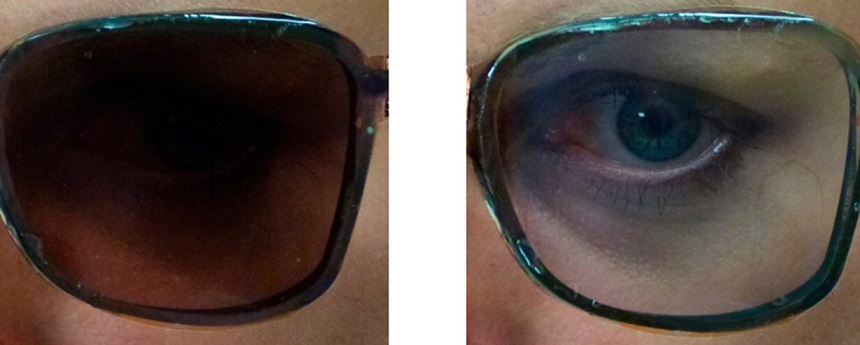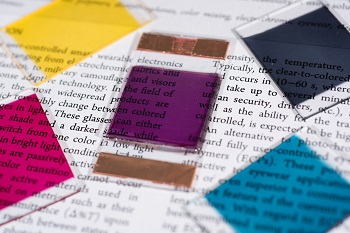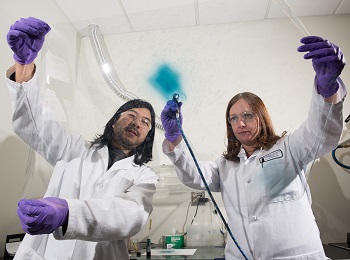Sunglasses on demand
Tap a button and the glasses go from light to dark in about a second

At a wearer’s command, an electric current can switch these sunglasses from dark to clear in about a second.
American Chemical Society
Light-sensitive sunglasses can shield your eyes from bright glare. But the glasses take minutes to darken — and later lighten up again. If you’re suddenly thrust into shadows, do you want to wait? Soon, you may not have to.
Chemists have made sunglasses that can switch from dark to clear and back with the tap of a button. Each changes takes only about a second.
Special plastics let the sunglasses work. The plastics are polymers — long chains of repeating groups of atoms. (The prefix “poly-“ means many.) These polymers also are semiconductors. “They’re able to transport an electric charge,” says Anna Österholm. She and Eric Shen work on the team of chemists who designed the new sunglasses at the Georgia Institute of Technology in Atlanta.

In the sunglasses, the electrochromic polymer acts like one piece of bread in a sandwich of layers, explains Shen. The other piece of “bread” for the sandwich is another conducting polymer. Its job is to store an electric charge. Unlike the electrochromic polymer, the second polymer always remains colorless.
A gel sits between the layers. That gel is an electrolyte, meaning it contains ions — charged particles — in solution. Those ions carry a charge between the two polymers.
Applying an electric current to the polymer sandwich triggers chemical reactions called oxidation and reduction. These reactions involve the loss or gain of electrons, and they always happen together. “If there’s an oxidation occurring in one place, there has to be a reduction somewhere else to balance it out,” Österholm explains.
When the current travels in one direction, the electrochromic-polymer layer loses electrons, and the layer at the other side of the sandwich gains electrons. Now the lens appears clear.
Switching the direction of the electric current reverses the process. The always-colorless plastic layer loses electrons and becomes oxidized. The electrochromic layer now gains back electrons (and becomes reduced). This darkens the glasses again.

Different types of electrochromic polymers would give the sunglasses different colors. Imagine the polymers as long chains. “Based on whether they’re extremely flat or extremely twisted, you can change how they absorb light,” says Shen.
Most polymers go straight from colored to clear. But polymers also can be blended like watercolor paints. That lets the team develop different shades of brown.
One pair of sunglasses can’t yet produce all the colors of the rainbow. But the team of scientists is exploring how to let the lenses take on a range of colors. The browns can have in-between states, Shen notes. And it might be possible to vary the color by using something other than plus or minus one volt.
The researchers reported on the new color-changing sunglasses in the January 28 ACS Applied Materials & Interfaces.
One big advantage to the new sunglasses is that their color-changing polymer can be dissolved in a liquid, says Jennings. That allows thin layers of it to be sprayed onto various materials. Other methods now being used to apply such polymers generally cost more and use more energy. They also require high temperatures and may produce more toxic fumes.
Jennings’ own work with electrochromic polymers focuses on smart windows. Such windows “can be made to selectively absorb ultraviolet or infrared light,” Jennings explains. Infrared wavelengths can be warming. Thus, the new windows can keep heat and light “out during summer daytime but allow it in during winter daytime,” Jennings notes.
The windows also can help at night. Radiated heat — infrared wavelengths — can be kept inside on cold winter nights. On summer nights, the windows can let that extra heat escape.
Until now, smart windows have been constructed of glass and a see-through solid layer that conducts electricity. But that solid conducting layer is very costly. Jennings’ team recently found a way to replace it with a liquid layer. Qing Wang from the National University of Singapore and others also worked on the team. Their new layer could help lower the cost for these energy-saving windows. A report on their work appears in the February 4 ACS Applied Materials & Interfaces.
Power Words
(for more about Power Words, click here)
anode The positively charged electrode in a battery or an electrolytic cell. It attracts negatively charged particles.
atom The basic unit of a chemical element. Atoms are made up of a dense nucleus that contains positively charged protons and neutrally charged neutrons. The nucleus is orbited by a cloud of negatively charged electrons.
battery A device that can convert chemical energy into electrical energy.
cathode The negatively charged electrode in a battery or an electrolytic cell. It attracts positively charged particles.
chemistry The field of science that deals with the composition, structure and properties of substances and how they interact with one another. Chemists use this knowledge to study unfamiliar substances, to reproduce large quantities of useful substances or to design and create new and useful substances. (about compounds) The term is used to refer to the recipe of a compound, the way it’s produced or some of its properties.
deposition The act of placing or depositing one thing on something else.
dye (noun) A substance that adds or changes the color of something. (verb) To apply a colorant to something.
electric charge A basic property of matter that makes it experience a force inside an electric field. Charges can be either positive or negative.
electric current A flow of charge, called electricity, usually from the movement of negatively charged particles, called electrons.
electron A negatively charged particle usually found orbiting the outer regions of an atom; also, the carrier of electricity within solids.
electrochromic Relating to a substance whose ability to absorb different wavelengths of light depends upon the number of electrons its molecules have. The color of electrochromic materials changes in the presence of an electric field.
electrolytes In chemistry, liquids or gels that contain ions in solution. In physiology,minerals in the blood and other bodily fluids that carry electrical charges.
engineering The field of research that uses math and science to solve practical problems.
infrared light A type of electromagnetic radiation invisible to the human eye. The name incorporates a Latin term and means “below red.” Infrared light has wavelengths longer than those visible to humans. Other invisible wavelengths include X rays, radio waves and microwaves. It tends to record a heat signature of an object or environment.
ion An atom or molecule with an electric charge due to the loss or gain of one or more electrons.
lens (in biology) A transparent part of the eye behind the colored iris that focuses incoming light onto the light-absorbing membrane at the back of the eyeball. (in physics) A transparent material that can either focus or spread out parallel rays of light as they pass through it.
molecule An electrically neutral group of atoms that represents the smallest possible amount of a chemical compound. Molecules can be made of single types of atoms or of different types. For example, the oxygen in the air is made of two oxygen atoms (O2), but water is made of two hydrogen atoms and one oxygen atom (H2O).
organic (in chemistry) An adjective that indicates something is carbon-containing; a term that also relates to the chemicals (including carbon) that make up living organisms.
oxidation A process that involves one molecule’s theft of an electron from another. The victim of that reaction is said to have been “oxidized,” and the oxidizing agent (the thief) is “reduced.” The oxidized molecule makes itself whole again by robbing an electron from another molecule. Oxidation reactions with molecules in living cells are so violent that they can cause cell death. Oxidation often involves oxygen atoms — but not always.
oxygen A gas that makes up about 21 percent of the atmosphere. All animals and many microorganisms need oxygen to fuel their metabolism.
polymer Substances whose molecules are made of long chains of repeating groups of atoms. Manufactured polymers include nylon, polyvinyl chloride (better known as PVC) and many types of plastics. Natural polymers include rubber, silk and cellulose (found in plants and used to make paper, for example).
radiate (in physics) To emit energy in the form of waves.
reactive (in chemistry) The tendency of a substance to take part in a chemical process, known as a reaction, that leads to new chemicals or changes in existing chemicals.
redox A short-hand term in chemistry for reactions that involve reduction and/or oxidation, changes that occur with the gain and/or loss of an electron.
reduction In chemistry, a process in which an atom gains an electron by stealing it from another atom or molecule. Reduction is the opposite of oxidation.
semiconductor A material that sometimes conducts electricity. Semiconductors are important parts of computer chips and certain new electronic technologies, such as light-emitting diodes.
spectrum A range of related things that appear in some order. (in light and energy) The range of electromagnetic radiation types; they span from gamma rays to X rays, ultraviolet light, visible light, infrared energy, microwaves and radio waves.
ultraviolet A portion of the light spectrum that is close to violet but invisible to the human eye.
voltage A force associated with an electric current that is measured in units known as volts. Power companies use high-voltage to move electric power over long distances.







